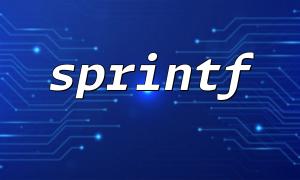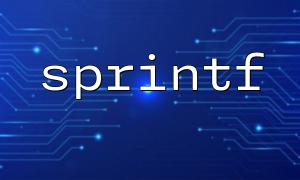In daily PHP development process, logging is an indispensable link. It not only helps us troubleshoot problems, but also records the key trajectory of the program's operation. In terms of log formatting, the sprintf() function is a very flexible and efficient tool. This article will take you into a deep understanding of how to use sprintf() to elegantly build log information and master some advanced techniques to make your log management more handy.
sprintf() is a function in PHP for formatting strings. Its function is to format one or more variables and insert them into the string according to the specified format template. The basic syntax is as follows:
sprintf(string $format, mixed ...$values): string
A simple example:
$log = sprintf("user %s Log in %s", "Alice", date("Y-m-d H:i:s"));
echo $log;
// Output: user Alice Log in 2025-04-22 15:30:00
In logging, we often need to output information in a unified format, such as timestamps, log levels, message content, etc. Here is a simple encapsulation function:
function logMessage($level, $message, $context = []) {
$timestamp = date('Y-m-d H:i:s');
$template = "[%s] [%s]: %s";
$formatted = sprintf($template, $timestamp, strtoupper($level), formatContext($message, $context));
file_put_contents(__DIR__ . '/app.log', $formatted . PHP_EOL, FILE_APPEND);
}
function formatContext($message, $context) {
foreach ($context as $key => $value) {
$message = str_replace("{{$key}}", $value, $message);
}
return $message;
}
// Sample call
logMessage("info", "user {username} Log in to the system successfully,sourceIPfor {ip}", [
"username" => "admin",
"ip" => "192.168.1.100"
]);
The output log is as follows:
[2025-04-22 15:35:10] [INFO]: user admin Log in to the system successfully,sourceIPfor 192.168.1.100
sprintf() supports various format controllers. Here are some common techniques:
$userId = 42;
echo sprintf("userID: %05d", $userId);
// Output: userID: 00042
$executionTime = 0.0385;
echo sprintf("Execution time: %.2f Second", $executionTime);
// Output: Execution time: 0.04 Second
echo sprintf("%-10s | %-10s", "user名", "Role");
// Output: user名 | Role
In some applications, we record logs accessing a URL. Using sprintf() can do this:
function logApiAccess($endpoint, $statusCode) {
$url = sprintf("https://api.gitbox.net/%s", ltrim($endpoint, '/'));
$log = sprintf("Access interface: %s,Status code: %d", $url, $statusCode);
file_put_contents(__DIR__ . '/api.log', $log . PHP_EOL, FILE_APPEND);
}
// Sample call
logApiAccess("/user/info", 200);
// Output: Access interface: https://api.gitbox.net/user/info,Status code: 200
sprintf() is an extremely powerful string formatting tool in PHP. Using it reasonably can greatly improve your log readability and maintenance. From basic templates to parameter replacement, from digital format control to URL splicing, mastering these techniques can make your logging system more professional.
Finally, it is recommended that you encapsulate sprintf() in a log processing class, and combine mechanisms such as exception processing and log-level classification to create a robust log framework. This is not only helpful for troubleshooting, but also reflects high-quality projects.















